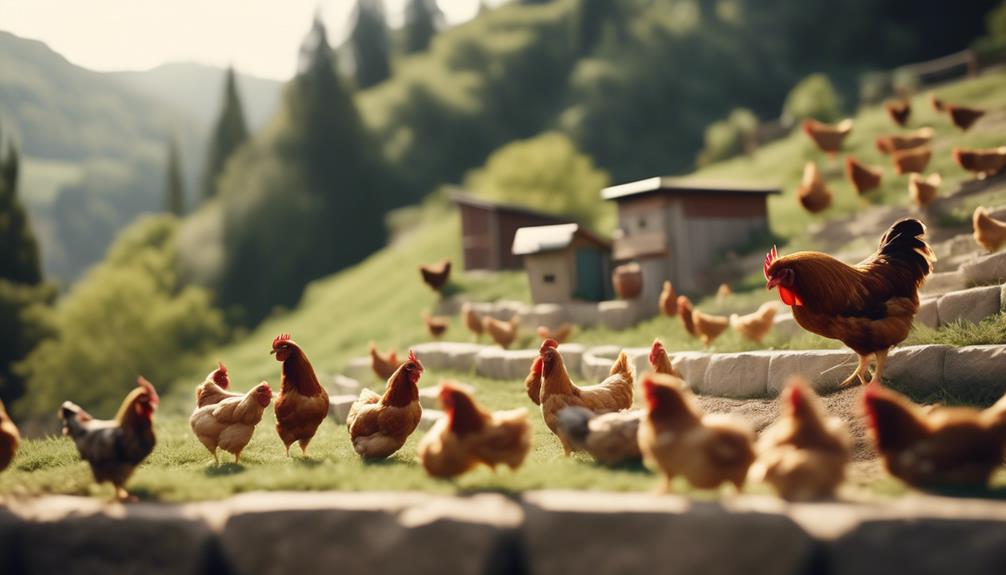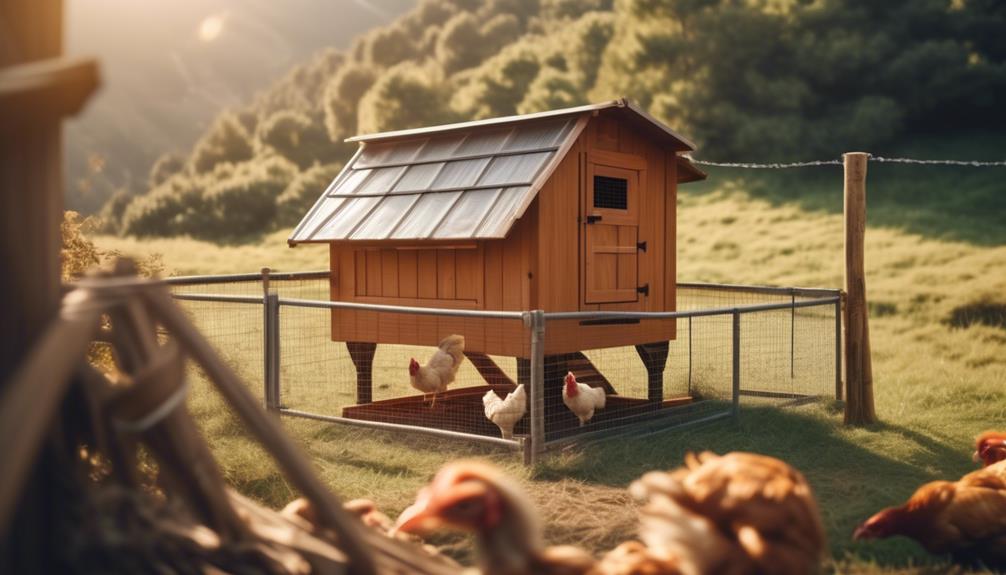Welcome to the world of chicken coop construction on a slope, where the art of building meets the challenge of uneven terrain.
Designing and constructing a chicken coop on a slope requires careful consideration and planning, as it involves a unique set of factors that must be taken into account to ensure the comfort, safety, and productivity of your feathered friends.
From maximizing space utilization and addressing climate concerns to protecting against predators and creating a secure environment, this discussion will provide you with the essential knowledge and strategies to master the art of building a chicken coop on a slope.
So, whether you're a seasoned builder or new to the world of coop construction, prepare to embark on a journey filled with valuable insights and practical tips that will help you create the perfect hillside haven for your hens.
Key Takeaways
- Building a chicken coop on a slope maximizes space utilization and provides shade and good ventilation for the chickens.
- It is important to ensure a secure foundation and evaluate the slope's stability and potential erosion when building on a slope.
- Proper water drainage and choosing materials that can withstand slope conditions are crucial considerations.
- When building on a slope, it is essential to address climate concerns by providing insulation, windbreaks, and proper ventilation for temperature regulation and preventing moisture buildup.
Benefits of Building on a Slope
Building a chicken coop on a slope offers numerous benefits that can enhance the efficiency and well-being of your flock. Designing the coop to fit the natural landscape can optimize space utilization and reduce the need for extensive leveling. This not only cuts down on construction costs but also allows for more creative and innovative designs.
Additionally, the slope provides natural shade, promoting a cooler environment during hot days, and enhances ventilation and drainage, preventing moisture buildup and reducing the risk of diseases. Cost considerations can also be taken into account when building on a slope. By utilizing the natural topography and materials found on-site, expenses for leveling, foundation, and landscaping can be minimized.
Considerations for Slope Construction
When constructing a chicken coop on a slope, several important considerations must be taken into account to ensure a successful and functional design. These considerations include:
- Retaining wall options: Building a sturdy retaining wall is essential to prevent soil erosion and maintain the stability of the slope. Options such as concrete blocks, stone, or timber can be considered based on the specific slope conditions.
- Slope stability assessment: It is crucial to assess the slope's stability before constructing the chicken coop. Professional assistance may be required to evaluate the slope and determine if any additional measures, such as terracing or reinforcement, are necessary.
- Proper water drainage: Adequate water drainage is essential to prevent flooding and ensure a dry environment for the chickens. Incorporating drainage systems, such as French drains or swales, can help divert water away from the coop.
- Appropriate materials selection: Choosing materials that can withstand the challenges posed by a slope is crucial. Opt for durable materials that are resistant to weathering, corrosion, and degradation caused by the slope's conditions.
Steps to Prepare Sloped Land

To prepare sloped land for building a chicken coop, it is essential to ensure a clear and level area devoid of debris and vegetation. This will provide a solid foundation for the structure and ensure stability. Here are the steps to follow:
| Steps to Prepare Sloped Land | ||
|---|---|---|
| Clear the area | Level the ground | Build retaining walls or terraces |
| Create a solid foundation | Install appropriate fencing |
First, clear the area by removing any debris and vegetation. This will create a clean slate for construction. Next, level the ground as much as possible to create a stable and even surface. Building retaining walls or terraces can help manage the slope and prevent soil erosion. It is important to create a solid foundation for the coop to ensure its structural integrity. Lastly, install appropriate fencing to deter predators and protect the chickens.
When preparing sloped land for a chicken coop, it is crucial to use building materials that can withstand the slope conditions. Additionally, consider integrating the coop design with the natural landscape to enhance its aesthetic appeal and functionality.
Addressing Climate Concerns
In order to create a climate-controlled environment for your chicken coop on a slope, it is important to implement measures that address various climate concerns while ensuring the comfort and well-being of your chickens. To achieve this, consider the following:
- Insulation options: Choose insulation materials that provide adequate thermal protection, such as foam boards or reflective barriers. Insulating the walls, ceiling, and floor of the coop can help regulate temperature and conserve energy.
- Ventilation strategies: Proper airflow is crucial for maintaining healthy air quality and preventing moisture buildup. Install vents or windows that can be opened and closed to control airflow. Consider the use of fans or natural ventilation techniques, such as strategically placed openings, to ensure optimal airflow.
- Weatherproofing: Select materials that are resistant to weathering and corrosion, such as treated lumber or metal roofing. Seal any gaps or cracks to prevent drafts and moisture infiltration.
- Climate control systems: For more advanced setups, consider incorporating climate control systems, such as thermostats, heaters, or evaporative cooling systems. These can help regulate temperature and humidity levels, ensuring optimal conditions for your chickens.
Dealing With Predator Challenges

One of the most critical aspects to consider when building a chicken coop on a slope is ensuring effective predator control measures. Predator deterrents and reinforcing coop security are essential to protect your chickens from potential threats.
To keep predators at bay, it is important to use predator-proof fencing and hardware cloth. These materials are designed to withstand the strength and persistence of predators, preventing them from gaining access to the coop.
Additionally, installing secure doors and windows will further prevent any potential entry points. Consider incorporating motion-activated lights or alarms as deterrents, as they can startle and scare away predators.
Regularly inspecting and reinforcing the coop for any weak points is also crucial in maintaining its security. In extreme cases, implementing additional measures such as electric fencing may be necessary to deter predators effectively.
Frequently Asked Questions
What Are Some Common Mistakes to Avoid When Building a Chicken Coop on a Slope?
Common mistakes to avoid when building a chicken coop on a slope include inadequate planning for drainage, using materials unsuitable for slope conditions, neglecting proper insulation and ventilation, and failing to reinforce the coop against predators. Design tips include implementing retaining walls or terraces and utilizing natural landscape features.
Are There Any Specific Challenges or Considerations When Building a Chicken Coop on a Steep Slope?
Challenges in chicken coop construction on a steep slope include ensuring a secure foundation, evaluating slope stability, managing water drainage, and selecting materials suitable for the terrain. Design considerations include maximizing space, ventilation, and predator protection.
How Can I Ensure Proper Drainage on a Sloped Land to Avoid Water Pooling Around the Coop?
Implementing effective drainage systems is crucial to avoid water pooling around a sloped chicken coop. Choose materials that promote proper water flow, such as gravel or perforated pipes, and consider incorporating swales or French drains to redirect excess water away from the coop.
Can I Use a Pre-Fabricated Chicken Coop on a Slope, or Is It Better to Build One From Scratch?
When building a chicken coop on a slope, it is generally better to build a custom coop rather than using a pre-fabricated one. This allows for better adaptation to uneven terrain and ensures proper drainage and stability.
Are There Any Specific Building Codes or Regulations That I Need to Follow When Constructing a Chicken Coop on a Slope?
When constructing a chicken coop on a slope, it is important to adhere to local building codes and regulations. Common mistakes to avoid include improper drainage, unstable foundations, and inadequate predator protection.
Conclusion
In conclusion, constructing a chicken coop on a slope offers numerous benefits and considerations for the well-being and safety of your flock.
By utilizing the space effectively, addressing climate concerns, and implementing effective predator deterrents, you can create a secure environment for your chickens.
An interesting statistic to note is that according to a study, chickens kept in well-designed coops on slopes have been found to exhibit lower stress levels and higher egg production compared to those kept in flat terrain coops.

